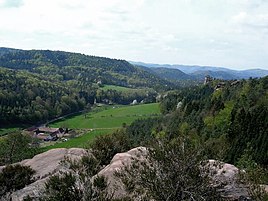Bärenbrunnerhof
|
Bärenbrunnerhof
Local community Busenberg
Coordinates: 49 ° 9 ′ 18 ″ N , 7 ° 51 ′ 10 ″ E
|
||
|---|---|---|
| Height : | 250 m above sea level NHN | |
| Postal code : | 66996 | |
| Area code : | 06391 | |
|
Location of Bärenbrunnerhof in Rhineland-Palatinate |
||
|
Bärenbrunnerhof (left)
|
||
The Bärenbrunnerhof is a large four-sided farm from the 18th and 19th centuries, which is located in the district of the Rhineland-Palatinate municipality of Busenberg ( district of Südwestpfalz ). It is a listed building .
geography
The farm is located in the German part of the Wasgau , which is formed from the southern part of the Palatinate Forest ( Rhineland-Palatinate ) and the northern part of the Vosges ( Bas-Rhin and Moselle departments , France), about 4 km northeast of the core community in a basin at the end of the Bärenbrunn Valley . This runs between the Winterberg ( 463 m ) in the north and the Löffelsberg ( 445 m ) in the south. The farm can only be reached from Busenberg via the neighboring community of Schindhard, which is located near the entrance to the valley ; Kreisstraße 41 serves as a connection .
history
The nucleus of the farm was the village of Bärenbrunn , which was established in the 14th century and which was completely destroyed in the Thirty Years' War and never repopulated.
1712 gave nobles Philipp Heinrich Eckebrecht of Dürckheim by Erbbestandsbrief the farmer Nicholas Lorch from Bergzabern the fields, meadows and forests of Bärenbrunn for an annual leasehold of 50 guilders . Lorch laid out today's yard and a mill.
After the French Revolution of 1789 had spread to the Electoral Palatinate , the aristocracy's goods were expropriated and auctioned at the beginning of the 19th century. The mill was bought by the miller Jean Ganter for 800 guilders, the farm and the associated land bought by the previous tenant Friedrich Haage for 4000 guilders . Soon afterwards, the farm and mill were transferred to Jakob Rebholz from Merzalben . In 1830 Johannes Guth leased the Bärenbrunnerhof. His descendants, who later bought the property, are still the owners of the farm today. This underwent structural changes in the 19th century, which are also classified as worthy of monument.
Todays use
The Bärenbrunnerhof is operated as an organic farm with a restaurant and also has holiday apartments, a campsite and an outdoor shop for sport climbers . In the Palatinate Forest climbing area, they prefer to use the Dahner Felsenland , which also includes the rock formations on the edge of the Bärenbrunner Valley.
Web links
Individual evidence
- ↑ a b General Directorate for Cultural Heritage Rhineland-Palatinate (ed.): Informational directory of cultural monuments - district of Südwestpfalz. Mainz 2020, p. 7 (PDF; 8.7 MB).



